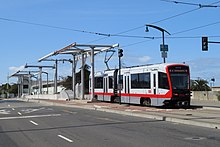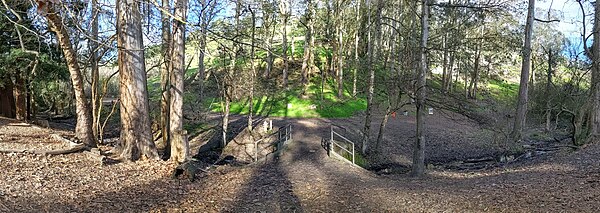Islais Creek
| Islais Creek | |
|---|---|
City and County of San Francisco, California | |
| • coordinates | 37°44′51″N 122°23′16″W / 37.74750°N 122.38778°W[5] |
| • elevation | 1 ft (0.30 m)[6] |
City & County of San Francisco, California | |
• coordinates | 37°44′54″N 122°22′32″W / 37.74833°N 122.37556°W[5] |
• elevation | −10 ft (−3.0 m)[5] |
| Length | 1 mi (1.6 km)[5] |
Islais Creek[pronunciation?] or Islais Creek Channel (previously known as Du Vrees Creek, Islais Channel and Islais Swamp)[7] is a small creek in San Francisco, California. The name of the creek is derived from a Salinan Native American word "slay" or "islay", the name for the Prunus ilicifolia wild cherries. Around the time of the Gold Rush, the area became an industrial hub, and the condition of the creek worsened. After the devastating 1906 San Francisco earthquake, the city decided to reclaim the creek using earthquake debris, reducing the waterbody to its present size. Though much of Islais Creek has been converted to an underground culvert, remnants still exist today at both Glen Canyon Park and Third Street. Several community organizations are dedicated to preserve these remnants, as they are important wildlife habitats.
Course
The historic Islais Creek, the largest body of water in the city covering an area of nearly 5,000 acres (7.813 sq mi; 20.234 km2),
From its sources in the Glen Canyon, the entire creek stretched about 3.5 miles (5.6 km) to the
In 2007, the San Francisco Public Utilities Commission, which manages the city's water, began investigating the possibility of "daylighting" underground portions of the creek.[14] As of 2009, remnants of the creek remain inside the Glen Canyon Park[8] and a 1-mile (1.6 km) channel near Third Street where Islais Creek debouched into the bay.
History


The history of Islais Creek dates to the 18th century.
A railroad trestle was built over the creek and tidal flats in the 1860s and in a lawsuit that went up to the
In 1871, the area along the creek became known as the city's "New Butchertown"
After the 1906 earthquake, San Francisco Board of Supervisors voted to fill the creek with earthquake debris, reducing the creek to its present size.[13] During World War II, it served as docking areas for large ocean-going tugs. The area also located the largest copra coconut processing plant in the United States West Coast.[4] In fact, the abandoned five-story high copra crane, used to transport large amount of copras from ships to the plant as late as 1974, still remains on the creek bank preserved as a historic landmark.[1][18] In the 1950s, Islais Creek was home to the largest sardine canning industry in the world.[10] The deteriorated condition of the creek gradually improved after the construction of a water treatment plant in 1970.[1] Today, the majority of the creek is covered and transformed into a culvert with its remnants flowing at Glen Canyon and near the bay.
Many local community organizations were set up to improve the condition of the creek and nearby areas. Friends of Islais Creek, established back in 1984, and David Erickson, a local community figure, were committed to build a waterfront park in Islais Creek. The initial plan for a park was finally launched in 1988 with a $50,000 grant from the State Department of Water Resources as well as community groups in
On November 19, 2001, construction crews, while preparing to drill an electrical conduit (consisting of six large 115kV electrical cables) across the creek for the Muni Metro T Third Street light rail line, cracked the concrete sewer underground which carries more than 80 million gallons of sewage a day. The incident flooded the creek and its adjacent Muwekma Ohlone Park with sewage. The park had to be excavated to make way for the repairing of the sewer pipe.[19][21] It was estimated that it would take more than $101,660 to repair and $65,000 for wildlife habitat restoration.[19]
The remaining Islais Creek Park is next to Cargo Way and 3rd Street. It is home to a historical information sign, a short trail, public art created from a copra loading crane, and a pier with a dock for small boats.[22]
As of December, 2017, the copra crane is lying on its side and the restoration project on hold due to jurisdiction and cost problems.[23]
Health hazard
Since Islais Creek is a culvert that carries storm water, domestic sewage, and industrial wastewater, it is possible for the sewage to overflow. Such overflow can cause a public health hazard as Islais Creek displays higher level of heavy metals, PCBs, bacteria, as well as organochlorines than other parts of the San Francisco Bay.[24][25]
Transportation
The Third Street Bridge is the major crossing of the creek, carrying T Third Street light rail line and Third Street.
Notes and references
- ^ a b c d e f Jeanne Alexander. "Islais Creek History". National Park Council. Archived from the original on May 9, 2008. Retrieved May 25, 2008.
- ^ Ron Sullivan (December 7, 2002). "Roots of native names". San Francisco Chronicle. Retrieved November 3, 2007.
- JSTOR 1495525.
Gudde concludes that the word "islay" originated in a Salinan word slay; Islay was the Spanish version of their word
- ^ a b c d Pearl Winaker; Bernard C. Winn. "History of Islais Creek". islaiscreek.org. Retrieved May 25, 2008.
- ^ a b c d "Islais Creek Channel". Geographic Names Information System. United States Geological Survey, United States Department of the Interior. 2000-06-14. Retrieved December 10, 2007.
- ^ Source elevation derived from Google Earth search using GNIS source coordinates.
- ^ According to the Geographic Names Information System by USGS, other lesser known variant names for Islais Creek or Islais Creek Channel include Arroyo Islais, El Arroyo De Los Yslais, Islar Creek, and Du Urees Creek.
- ^ a b c Glen Canyon Park and O'Shaughnessy Hollow (PDF), San Francisco Recreation and Parks Department, 2006, pp. Section 6.3 of Significant Natural Resources Areas Management Plan, archived from the original (PDF) on August 9, 2007, retrieved February 3, 2007,
This section contains several detailed maps on "Soils, Land Features, and Trails," "Vegetation," and "Sensitive Species and Bird Habitat.
- ^ a b c Amber Hasselbring; David Erickson (April 20, 2007). "Conversation about Islais Creek and the Now Destroyed Muwekema Ohlone Park". Neighborhood Public Radio. Retrieved August 20, 2008.
- ^ a b c "San Francisco's Old Clam House on the Lost Waterfront - San Francisco History - Guidelines Newsletter". www.sfcityguides.org.
- ^ William C. Sharpsteen. "Vanished Waters of Southeastern San Francisco". California Historical Society Quarterly, Vol. XXI, No. 2, June 1941. The Virtual Museum of the City of San Francisco. Archived from the original on February 15, 2008. Retrieved May 25, 2008.
- ^ Creek & Watershed Map of San Francisco (Map). 1 : 25,800. Cartography by Oakland Museum of California. M.T. Ramirez-Herrera, J.M. Sowers, C.M. Richard. 2006. Retrieved March 16, 2009.
- ^ a b c d e "Islais Creek Basin P.1-5" (PDF). San Francisco Public Utilities Commission. September 2007. Archived from the original (PDF) on 2009-03-19. Retrieved 2009-03-19.
- ^ "Urban Watershed Planning". San Francisco Public Utilities Commission. Retrieved 10 April 2010.
- ^ a b Carl Nolte (November 30, 1996). "New Current for Historic S.F. Waterway". San Francisco Chronicle. Retrieved November 2, 2007.
- ^ Kevin Cutler (April 2006). "Islais Creek: From Stream to Sewer". The Noe Valley Voice. Retrieved August 20, 2008.
- ^ Joe Eaton, Ron Sullivan (January 14, 2009). "S.F. history lesson runs through Islais Creek". San Francisco Chronicle. Retrieved March 15, 2009.
- ^ Jeanne Alexander. "A bird's eye view of The Blue Greenway: Islais Creek". Neighborhood Parks Council. Archived from the original on April 5, 2008. Retrieved August 20, 2008.
- ^ a b c Joe Garofoli (July 28, 2003). "Urban oasis garden in legal limbo in S.F." San Francisco Chronicle. Retrieved November 2, 2007.
- ^ Paul McHugh (June 28, 2001). "Ultimate dream: a bay water trail". San Francisco Chronicle. Retrieved November 2, 2007.
- ^ Maurice B. George (July 29, 2004). "Muni destroys park, dumps sewage, wastes millions crossing Islais Creek". Indybay. Retrieved August 21, 2008.
- ^ Viera, Julia (2017). "Islais Creek". Parks Alliance. Retrieved 12 October 2017.
- ^ Iacuessa, Michael (December 2017). "Islais Creek SFMTA Facility Fails to Deliver on its Promises". The Potrero View. Retrieved 4 August 2019.
- ^ Randall Frost (March 26, 2005). "Storm Runoffs May Pose Health, Environmental Risks". Neighborhood Newswire. Archived from the original on October 3, 2006. Retrieved August 21, 2008.
- ISBN 978-0-8493-8041-9. Retrieved August 24, 2008.
- ^ Michael Cabanatuan (January 6, 2007). "3rd Street light rail nearly at finish line". San Francisco Chronicle. Retrieved November 3, 2007.
- ^ "Illinois Street Bridge". Retrieved May 7, 2011.
See also
External links
- "Guide to San Francisco Bay Area Creeks - Islais Creek". Oakland Museum of California.
- Lowenthal, Benjamin. "Urban Paradise Lost". Archived from the original on 2003-04-06. Retrieved 2003-04-06.
- Gaar, Greg; Miller, Ryder W. (2006-06-28). San Francisco: A Natural History. Arcadia Publishing. p. 45. ISBN 9780738529875.
islais creek.
- "360° views of Islais Creek Basin as seen from the Third Street Bridgee". Hidden Ecologies. 2006-01-22. Archived from the original on 2006-02-28.
- "360° views of Islais Creek Basin from Third Street Bridge". Hidden Ecologies. 2006-01-22. Archived from the original on 2006-02-28.
- Diehl, Jeff. "The Attempted Homicide of a Sanctuary". Spots Unknown.
- "The Islais Creek Film".
- "Islais Creek Watershed". Oakland Museum of California. Retrieved 2019-04-14.

